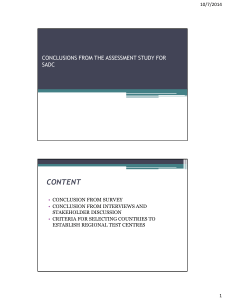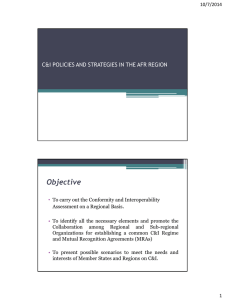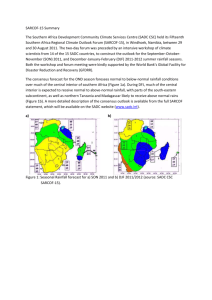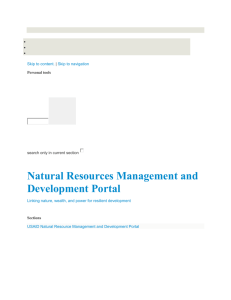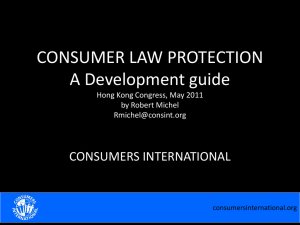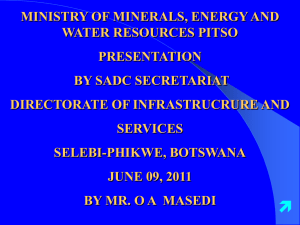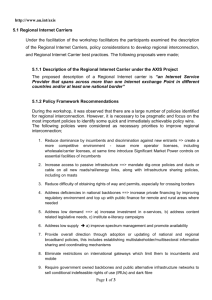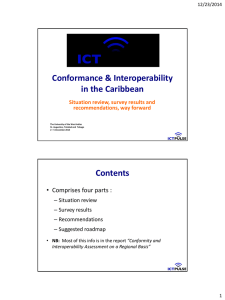Objective . C&I POLICIES AND STRATEGIES IN THE AFR REGION
advertisement
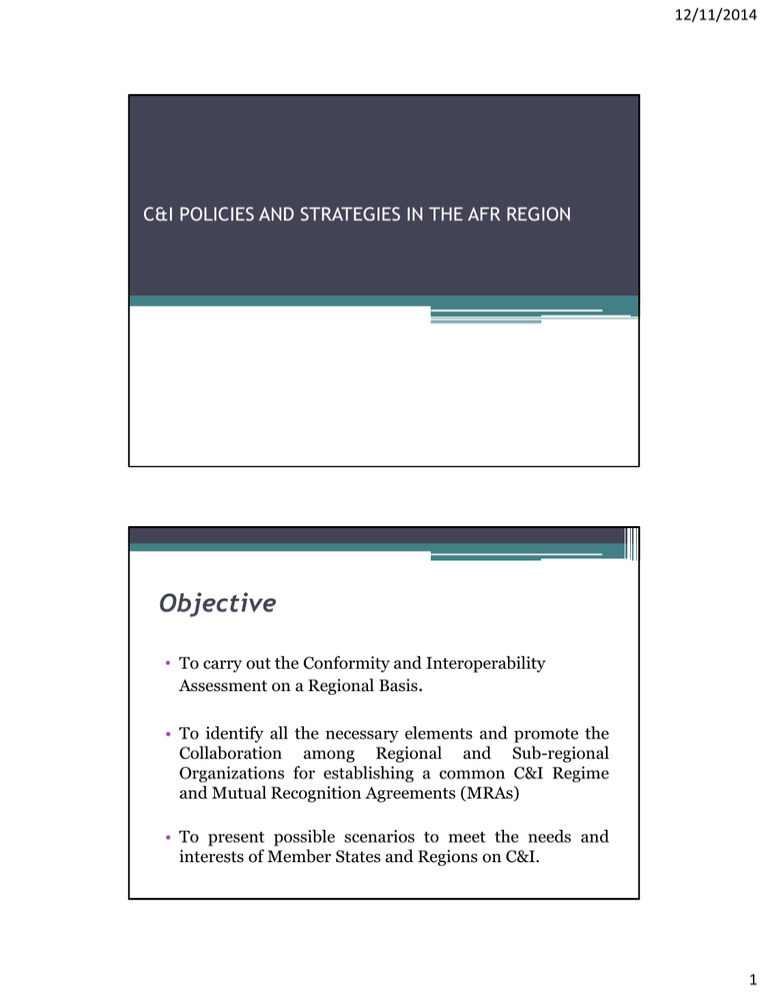
12/11/2014 C&I POLICIES AND STRATEGIES IN THE AFR REGION Objective • To carry out the Conformity and Interoperability Assessment on a Regional Basis. • To identify all the necessary elements and promote the Collaboration among Regional and Sub-regional Organizations for establishing a common C&I Regime and Mutual Recognition Agreements (MRAs) • To present possible scenarios to meet the needs and interests of Member States and Regions on C&I. 1 12/11/2014 Scope of Assessment • The general aspects of SADC region • Regulatory framework and Institutions (per country) • Accreditation, Laboratories, certification bodies and Marking; and a proposals • Recommendations for establishing common C&I regime and MRAs. Authority for Action on Conformance and Interoperability • ITU-D is instructed by Resolution 47 of the World Telecommunication Development Conference (WTDC-10); • ITU-R by Resolution 62 of the Radiocommunications Assembly (RA-12); • ITU-T by Resolution 76 of the World Telecommunication Standardization Assembly (WTSA-12). • Resolution 177: ITU Plenipotentiary Conference (PP-10) and • ITU Council Decisions: (2009, 2010, 2011, 2012, 2013) have endorsed the implementation of the C&I programme. 2 12/11/2014 Deliverables/Outcome of Assessment • Possible Scenarios for establishing Common C&I Regime and Mutual Recognition Agreements; • Possible ways to facilitate the implementation of ITU Conformity and Interoperability programs, especially in the areas of Capacity building and the Establishment of Test Centers on regional and sub-regional basis. • Regional or sub-regional organizations suitable to perform conformity assessment testing including the function of MRA coordination; • Entities that are capable of providing funding opportunities to support the establishment of testing centers in the region. Methodology • The Assessment was done in two stages. The C&I Assessment in the SADC region was accomplished by the two ITU consultants - Joshua Peprah leader - Dr Thomas Senaji 3 12/11/2014 First Stage • Preparation of C&I Assessment Questionnaire • Study of existing documents relating to C&I, specifically the test centers, feasibility study and the draft mutual recognition agreements/arrangements (MRAs) • Establishing high level contacts with Member administrations through the ITU Regional office for Africa • Dispatch of conformance and interoperability Questionnaires • Face to face meetings with officials in member administrations to obtain perspectives and support for the C&I project. Second Stage • Analysis of completed questionnaires from SADC Member States to complement the findings of the Missions to SADC, CRASA, ICASA and BOCRA • Discussions with ITU Regional team on C&I program and Development of final Report 4 12/11/2014 CHALLENGES • Only a few countries submitted responses to the C&I survey questionaires sent out • Team also relied on perspectives from the SADC secretariat and other secondary sources. FINDINGS-Capacity for C&I in SADC Region • No training (especially on digital-migration) among SADC member states • No C&I test facilities in SADC member states • No training for/or trained trainers (TOT) on C&I within SADC • No C&I training for consumers of ICTs 5 12/11/2014 FINDINGS FROM THE SURVEY • General aspects of the Region ▫ Southern African region Estimated population -284 million GDP - USD 655 billion Land size of 9,882,959km2. ▫ South Africa, the biggest economy in the sub-region. most populated country in the sub-region. Estimated population – 51 million GDP - USD408 billion land size -1,219,090km2. literacy rate - 88.7% for persons above 15 years. FINDINGS FROM THE SURVEY • General aspects of the Region ▫ Namibia total area - 824,292 sq km, an estimated population – 2.1 million GDP - USD12.billion Literacy rate - 89%. 6 12/11/2014 FINDINGS FROM THE SURVEY • General aspects of the Region ▫ ▫ ▫ ▫ Botswana Total area of 581,730 km2, Estimated population of 2,101,715 GDP of USD17.33 billion. FINDINGS FROM THE SURVEY • General aspects of the Region ▫ Botswana reported the highest telecom penetration rate of 153% among the three respondents for mobile services. ▫ They also reported a penetration rate of 48% for Internet. ▫ The country has three major telecom service providers. ▫ South Africa, the biggest telecommunications market in the subregion has a penetration of 128.7% for mobile services and 9.3% for Internet services. ▫ South Africa has three mobile network operators and two fixed line operators. 7 12/11/2014 FINDINGS FROM THE SURVEY • Regulatory framework and Institutions (per country) ▫ South Africa and Botswana have regulatory frameworks and regulations which establish technical requirements for products and services, to be legally imported and deployed in the marketplace. ▫ Namibia’s Type Approval Regulations is however under development and still in draft form. ▫ Tanzania also has a regulatory framework in place since 2012. FINDINGS FROM THE SURVEY • South Africa is the only country which has adopted comprehensive conformity assessment schemes for market entry. Includes certification through testing in labs and labeling. • Botswana relies on documents from test labs outside the countries and also use proxies such as EC, FCC and other for conformity assessment. • SABS Product Marking Scheme is based on ISO/IEC 17025, which outlines the general requirements for the competence of testing and calibration laboratories. 8 12/11/2014 FINDINGS FROM THE SURVEY • All the respondents have compulsory legislations and regulations dealing with ICT and telecom products. • With the exception of South Africa, all the other countries are having challenges with enforcement due to capacity constraints. • None of the respondents have MRAs , South Africa will however accept test reports that are issued by an Accredited Test Laboratory (ATL), • South Africa and Botswana have national standards system and national SDOs. There was no response on this issue from Namibia. FINDINGS FROM THE SURVEY Accreditation • South Africa is the only country with an accreditation body;South African National Accreditation System (SANAS). SANAS covers ICT and Telecom products and Electrical Equipment and other unrelated scopes. 9 12/11/2014 FINDINGS ON THE SURVEY Laboratories • South Africa is the only country with accredited test labs. These include Telkom, SABS, Gerotek, Test Africa; • ICT Laboratories are accredited by SANAS. CRITERIA FOR SELECTING COUNTRIES TO ESTABLISH REGIONAL TEST CENTRES • National Government’s Commitment • Technical and Financial Capacity • Demography and Market Size • Political, Economic and Legal Stability 10 12/11/2014 CONCLUSIONS • Survey has shown that there is lack of capacity and infrastructure for an effective conformance assessment regime. • With the exception of South Africa, the report can confidently say that all the other SADC member countries have no test labs and a certification body. • The countries also lack MRAs co-ordination. • There is lack of capacity in the development and implementation of frameworks and regulations for conformance assessment. • The huge economy, high literacy rate and large telecommunications market of South Africa makes it an attractive destination for setting up an accredited test lab. The government with relatively more resources available has the ability to set up a certification body and also to build up capacity for conformity assessment. WAY FORWARD FOR ESTABLISHING COMMON C&I REGIME AND MRAs • Short-term Approach ▫ Workshops should be organized for the SADC region to aid in C&I regulatory frameworks and regulations. ▫ There should also be workshops for test reports analysis, development of technical requirements for C&I and the development of MRAs regime among SADC member countries. ▫ Capacity building workshops with practical exposure can also be held for relevant personnel in the sub-region. ▫ ITU in collaboration with SADC secretariat should initiate this process. 11 12/11/2014 WAY FORWARD FOR ESTABLISHING COMMON C&I REGIME AND MRAs • Medium-term Approach ▫ SADC member countries should harmonize C&I regimes or develop MRAs to better manage the process and to facilitate the process of setting up a test lab for the sub-region. ▫ Regulators and other stakeholders in the sub region should persuade their governments to prioritize the setting up of a test lab by clearly highlighting its benefits. ▫ They could also consider the setting up of a test lab through a public-private partnership. SADC C&I PRESENTATIONS • THANK YOU 12
